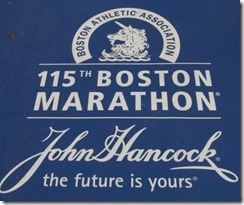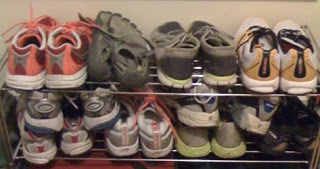 Image via Wikipedia
Image via WikipediaA few weeks ago I posted a slow-motion video of Ryan Hall from the 2010 Boston Marathon that was taken by a pair of my undergraduate students (thanks Erin and Daniella!). They headed down to Newton on Marathon Monday to watch and film portions the race, and as it turns out, they managed to capture some amazing slow-motion video of approximately the first 1000 runners to pass by near the 17 mile marker of the marathon. Below is a clip showing slow-motion video of the first six men to pass by the point where they were stationed. The video was filmed at 300 frames-per-second with a Casio Exilim EX-F1 digital camera (you can read my overview of the Casio EX-F1 here if you’re interested in the technology), so this is true high-speed video.
Elite Male Runners in Slow Motion – 2010 Boston Marathon from Runblogger on Vimeo.
Video clip of elite males running near mile 17 of the 2010 Boston Marathon. Video courtesy of https://runblogger.com.
The runners in the clip are (in order)
1. Cheruiyot, Robert Kiprono (KEN, finishing time = 2:05:52, finish = 1st)
2. Merga, Deriba (ETH, finishing time = 2:08:39, finish = 3rd)
3. Kebede, Tekeste (ETH, finishing time = 2:07:23, finish = 2nd)
4. Kigen Kipkosgei, Moses (KEN, red/green shirt, finishing time: 2:12:04, finish = 8th)
5. Goumri, Abderrahim (Morocco, purple shirt closer to carmera, DNF)
6. Keflezighi, Mebrahtom (USA, finishing time = 2:09:26, finish = 5th)
And here’s a version that is slowed down even further:
Elite Men in the 2010 Boston Marathon – Super Slow Motion from Runblogger on Vimeo.
Video clip of elite males running near mile 17 of the 2010 Boston Marathon. Video courtesy of https://runblogger.com.
And here below again is the clip of Ryan Hall (USA, finish time = 2:08:41, finish = 4th).
Ryan Hall – Boston Marathon 2010 from Runblogger on Vimeo.
Video clip of Ryan Hall running near mile 17 in the 2010 Boston Marathon. Video courtesy of https://runblogger.com.
Now, I make no claims of being an expert on running biomechanics, however, I have spent countless hours over the past few months analyzing slow-motion video of footstrikes (over 1500 of them!) for a project I have been working on with some of my undergraduate students. As you can see with these videos, even at 300fps it can be hard at times to classify very borderline cases, and doing so with a regular camera at 30fps would be near impossible – this is why I’m hesitant to trust many of the videos of elites that I see posted on sites like YouTube. At 30fps, the gaps between image frames of a fast moving subject are so great that the accurate classification of a split-second event like where the foot meets the ground is extremely difficult. Furthermore, this video is a snapshot from only a single spot in a single race, and I have seen footstrike to vary even within a person due to factors like fatigue, suspected injury, etc. That being said, I think we can glean at least a small amount of insight from these Boston videos, and since the discussion of which type footstrike is most efficient and least likely to cause injury is all the rage right now, here is my footstrike analysis of these six runners based on this video clip:
1. Cheruiyot: left = midfoot, right = midfoot
2. Merga: left = midfoot, right = obscured
3. Kebede: left = heel, right = midfoot
4. Kigen: left = mifoot, right = midfoot
5. Goumri: left = heel, right = heel
6. Keflezighi: left = heel, right = heel
7. Hall: left = midfoot, right = midfoot
Rather than write up my thoughts in paragraph form, I thought instead I would just share a few random musings that have entered my head upon watching this, and let you comment and provide additional insight as you see fit – I consider my comments section to be an open forum, but let’s not let this devolve into a petty argument over barefoot/shod running as seems to so often happen when the topic of footstrike comes up these days.
1. Most of the elites shown here (and these are some of the absolute best in the world right now) are midfoot strikers, but this pattern is not universal. Both the 2009 (Merga) and 2010 (Cheruiyot) Boston winners are midfoot strikers here, but the 2009 NYC Marathon winner (Meb) is a clear heel striker. Furthermore, Goumri, who entered the 2010 Boston Marathon with the fastest marathon time of any of these guys (2:05:30 in the London Marathon in 2008), is also a clear heel striker. So it would seem, at least based upon this small sample (and I have a lot more video to look at in the coming months), that you can run really fast for a really long distance with either a midfoot or a heel strike.
2. These guys are running very, very fast. All of them are likely running at a sub 5-minute mile pace in this clip. For frame of reference, Cheruiyot’s average pace was 4:48 min/mile for the full 26.2 – to me this is hard to even comprehend! Thus, it’s hard to know for sure whether the footstrike patterns observed here are more a function of speed than anything else, but the presence of two heel strikers seems to go against this argument. Regardless, it would be interesting to get another video of each of these elite marathoners running at a more pedestrian 8:00 or 9:00 per mile pace. Maybe I’ll film myself running at a 4:48 pace and see what I look like (and believe me, that will take some serious effort on my part, and it won’t be nearly as pretty as what you see here!).
3. Both Cheruiyot and Meb appear to be wearing the same shoe – looks like the Nike Zoom Streak 3, It’s interesting to see how strikingly different (no pun intended!) their landing patterns are despite the similar speed and shoe type.
4. It would be easy for some to suggest that Meb or Goumri could be faster if they altered their stride to land on the midfoot, but it is equally possible that this would throw them off their naturally most efficient gait and make them slower. It is these types of questions that science needs to begin to address.
5. As far as what makes these men such impressively fast marathoners, my suspicion is that footstrike is probably fairly insignificant. I’m sure they all have VO2max values that are through the roof, they can sustain paces a at a percentage of VO2max that is far higher than the average person, they have amazingly high lactate thresholds, a preponderence of slow-twitch fibers in their relevant running muscles, and are amazingly economical in their running biomechanics (i.e., outstanding running economy). In other words, all of these men are physiologically gifted in ways that most of us could only dream about, and that, moreso than what their feet are doing when they contact the ground, is what makes them so fast. We have a tendency as humans to focus on what we can easily observe, measure, and control, and footstrike is one of those things. However, the relative importance of footstrike when compared to these other factors is in my opinion questionable.
6. I have a lot more video to analyze in the coming months, and I just wrapped up analysis on a big project from another marathon – I’m hoping to get this published soon, so stay tuned for that. There’s still a lot of science on running that needs to be done, and there are a lot of questions waiting to be answered, so my hope is that videos like this will stimulate discussion and testable hypotheses. If you have anything you’d like to add to the discussion, feel free to leave a comment and/or share this video on your own blog – my only request would be that you link back here if you do.



















Can’t wait to read your analysis and conclusions! Great stuff!
My son has one of those Casio cameras. When I get back to the road (healing a stress fracture now) I’m going to put his camera to good use!
Take care.
It appears this is a slight downhill segment of the Boston Marathon. The course drops from 129ft to 84ft from the 16.5 mile mark to the 17.5 miles. Thus, the runners are likely landing slighly further back on their foot than they would on a flat surface and definitely further back on their foot than they would on an incline.
My post was meant as a general comment, not in response to Bob.
It seems to me that age is an important factor here — at least that has been my experience. When I was young, I was definitely a heel-striker. No one told me to land on my heels, that’s just what I did the first time I put on running shoes.
By my late-30s, I started getting injuries like never before. I was ready to give up running when I heard about Chi Running. My research led me further to barefoot running, and when I tried it, Bingo!, no more injuries! Now, whether I run in shoes or barefoot, I try to have the same form and footstrike. So far, this has kept me injury-free, but I am eager to see if this remains the case as I ramp up my mileage.
As for all of these elite guys, it seems that most of them are midfoot strikers, but clearly that isn’t a prerequisite for running a 2:05 as Meb has demonstrated. However, all of these guys are still fairly young.
My guess is that the midfoot strikers will continue to run relatively injury free for the rest of their lives, but the heel strikers will eventually have to make a change or stop running.
Any kind of analysis would, I think, have to take age into account.
Looking forward to reading your research – thanks for sharing, Peter.
Great videos.
For what it’s worth, although not near the elite level of these guys, I’ve filmed myself (a 4minish miler), a teammte who runs 1:45 in the 800 and a couple of national level HS kids at a variety of speeds.
And my conclusion on that small sample is that footstrike does not change a ton from easy running (7min miles) down to about 800 pace. If someone runs mile-5k pace with a midfoot strike, they’ll run at 7min pace with a midfoot strike, maybe slighltly back but still midfoot. Same with if they heel strike when running slow, they will when running fast.
There’s a change when it comes to full sprinting in many. It’s not as clear cut. Some get more on the forefoot, some stay the same. I’ve seen heel strikers when running at that 800 to 7min pace range, but on their forefoot when sprinting. Similarly, I’ve seen heel strikers when running normal paces, continue to heel strike when sprinting.
Anyways, fascinating stuff. I’m planning on getting some high speed video this summer of elites racing on the track, so maybe we’ll get some more data to work with!
Fascinating video.
Very interesting. Thanks for sharing!
I know this is a really small sample, and therefore we can’t draw firm conclusions but I’d be interested in knowing what kinds of injuries these guys have had. The only one I know about is Meb, who suffered a hip fracture running in NYC a few years ago…..
Fantastic videos,
What interests me is the dorsi flexon of the runners ankles,
Try this, stand on one leg, press your foot into the ground and lock your ankle, now lean forward,
if you kept your foot pressing into the ground you will not fall forwards.
Now stand on one leg again, this time dorsi flex your ankle and you will fall forwards!
So when you are running once the foot lands on the ground your leg bone rotates forward over the ankle joint, any pressure downwards from your foot acts like a braking force, slowings the leg bones forward rotation.
On the other hand if you actively dorsiflex your ankle once the foot has landed you can increase you forward momentum and stride length!
P.S i note Meb has had quite a few injury problems over the years, could it be his heel strike?
Thank you for posting these videos. I have become a student of running form because of my own experiences. I am by all means a “beginner.” I only started running regularly a year ago. The first 3 or four months I went about it all wrong. I was over-training, and was probably in the wrong shoe among other things. I ended-up with severe ITBS along with PF and eventually tore my meniscus and needed surgery. When I returned from surgery I did a lot of research on running form as I knew the ITBS and maybe the other problems were at least related to poor form (and probably the other issues I mentioned before). I know for a fact that I was a heavy heel-striker. In the course of my research I came across the Newton Running website, and studied it. Over and over. It made sense to me. I got myself a proper coach. He is a big believer in the mid/fore strike and efficient running (He’s also a six-time Ironman and an eight-time Boston Qualifier and consistent 2:40:00 marathoner at 40 years old). He helped me as I worked-on converting my stride while running in my Asics Gel-Nimbus. It was fairly easy for me to convert, since I hadn’t really developed my own stride or bad habits to break. In December 2009 I purchased my first pair of Newton’s. I trained over 700 miles for the Boston Marathon in 2 pair of Newton’s and bought a 3rd pair to actually run the marathon in. I was able to remain almost completely injury-free the whole time. Now, even when I train in my Brooks Launch, I am a mid-foot/forefoot striker. I credit this form for keeping me injury free. I’m also over 6 feet tall and was 265 lbs. when I started and am now hovering around 200, so I’m sure there are other factors involved. I just wanted to give my own experience a an example.
Awesome – thanks for these!
I think your 2nd point about speed is important. These guys are running so fast that it’s a whole different ball game. They seem to be landing slightly in front of their center of gravity which is a classic no-no but probably makes sense when you are flying like that.
One element you may want to considered when evaluating footstrike is the slope of the running surface. If flat, you should see the runner’s true footstrike. For me, a mid-foot striker, I will get more forward, maybe on the balls of my feet going uphill (even slight inclines); and usually revert to subtle to severe heel striking going downhill to lessen the impact on my feet – it’s just easier for me (especially steeper hills). So you may want to make sure of the slope when evaluating a runner’s strike. Good luck with your study.
love the videos. It’s so much easier to see the actual foot strike in these. I think it should be noted that while a couple guys “heel strike” I think there are degrees of heel strike. While Meb is landing with his heel first, the transfer of weight and balance is so fast, there is no braking effect. Many beginning runners overstride and really jam into their heel on first contact causing more stress and decreasing their smoothness and efficiency.
Chad
http://brooklynrunning.wordpre…
Chad – Excellent point. Heel strikes are highly variable, and I have seen
this clearly in the videos that I have. There’s a big difference between
what Meb is doing here than in some of the really pronounced overstriders
that I have seen.
Pete